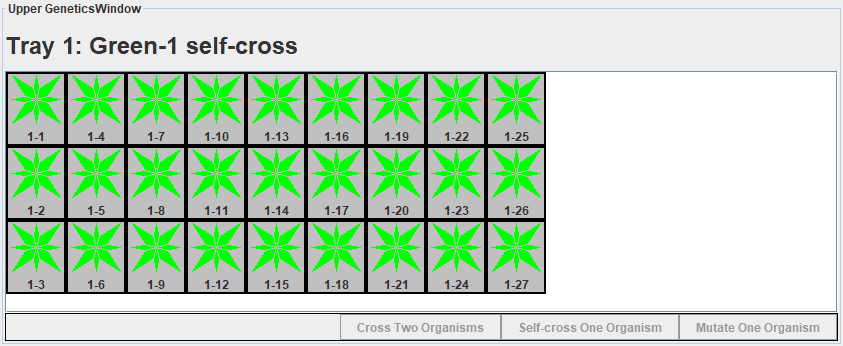Difference between revisions of "Eyoung20 week 2"
Jump to navigation
Jump to search
(→Part 1: added results for step 3) |
(→Methods and results: addimg green 1 self cross image) |
||
| Line 17: | Line 17: | ||
#The next step is two self cross all the colors we found using the software by selecting colors from the history trays and hitting the self-cross option. Green 1 and Green 2 are still being treated as two different colors due to the above results showing different results when they are combined with thew other colors. | #The next step is two self cross all the colors we found using the software by selecting colors from the history trays and hitting the self-cross option. Green 1 and Green 2 are still being treated as two different colors due to the above results showing different results when they are combined with thew other colors. | ||
#*the results of the Self-crosses were: | #*the results of the Self-crosses were: | ||
| − | #**Green 1: Green | + | #**Green 1: Green [[Image:eyoung20Green_1_self_cross.png]] |
#**Green 2: Yellow, blue, green | #**Green 2: Yellow, blue, green | ||
#**Red: white, red | #**Red: white, red | ||
Revision as of 15:46, 11 September 2019
Contents
Purpose
The puupose of this experiment is to use the Aipotu software to become more familiar with how genes effect the physical characteristics of organisms. This was done by determining the genes of the flowers of the software and how dominant and recessive properties effect the color, and how mutations can change them.
Methods and results
Part 1
- the first step was to run a cross breading experiment on the flower organisms. This experiment allowed the use of the software to determine how many different colors could be made by the flowers.
- The results of the crosses where:
- Green 1 - Green 2 : Green
- Green 1 - Red: Green, Black
- Green 1 - White: green
- Green 2 - red: purple, orange, yellow, blue
- Green 2 - white: blue, yellow
- Red - white: Red, White
- The results of the crosses where:
- The next step is two self cross all the colors we found using the software by selecting colors from the history trays and hitting the self-cross option. Green 1 and Green 2 are still being treated as two different colors due to the above results showing different results when they are combined with thew other colors.
- The next step was to see if we could achieve a pure bred flower of each of the colors. This was done by self-crossing one flower of the desired color and then repeatedly self-crossing a flower from the results of the desired color. This process should be repeated two to three times, and the final result should be chosen from a result group that is purely the desired color. The pure bred flower is then added to the greenhouse for later use. Not all of the colors where expected to be able to pure breed based on the earlier results.
- The Pure breeding results:
- Green 1: will pure breed
- Green 2: will not pure breed
- Red: will pure breed
- White: will pure breed
- Blue: will pure breed
- Yellow: will pure breed
- Black: will not pure breed
- Orange: will not pure breed
- Purple: will not pure breed
- The Pure breeding results:
- the next step was to figure out exactly which pure breeding colors when combined were able to make the non pure breeding or heterozyogous colors. This was done by crossing different combinations of different pure breed flowers that were saved to the greenhouse in the above step.
- The Results
- Green pure - red pure: Black
- Green pure - blue pure: Green
- Green pure - yellow pure:Green
- Green pure - white pure: Green
- Red Pure - blue pure: Purple
- Red Pure - Yellow Pure: Orange
- Red pure - white pure: Red
- Blue Pure - Yellow pure: Green
- Blue Pure - white pure: Blue
- Yellow pure - white pure: Yellow
- The Results
